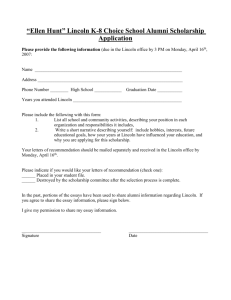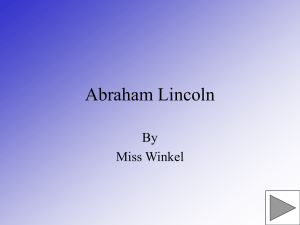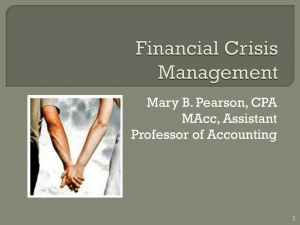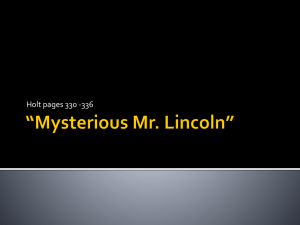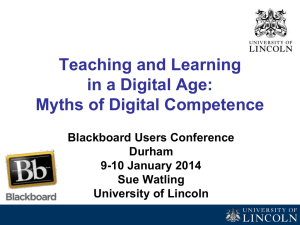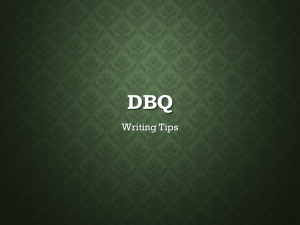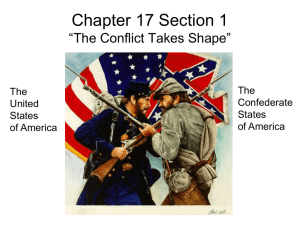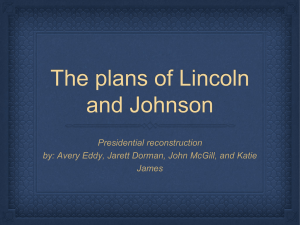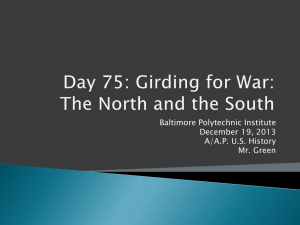Bruce Lincoln`s Holy Terrors: Thinking About Religion After
advertisement
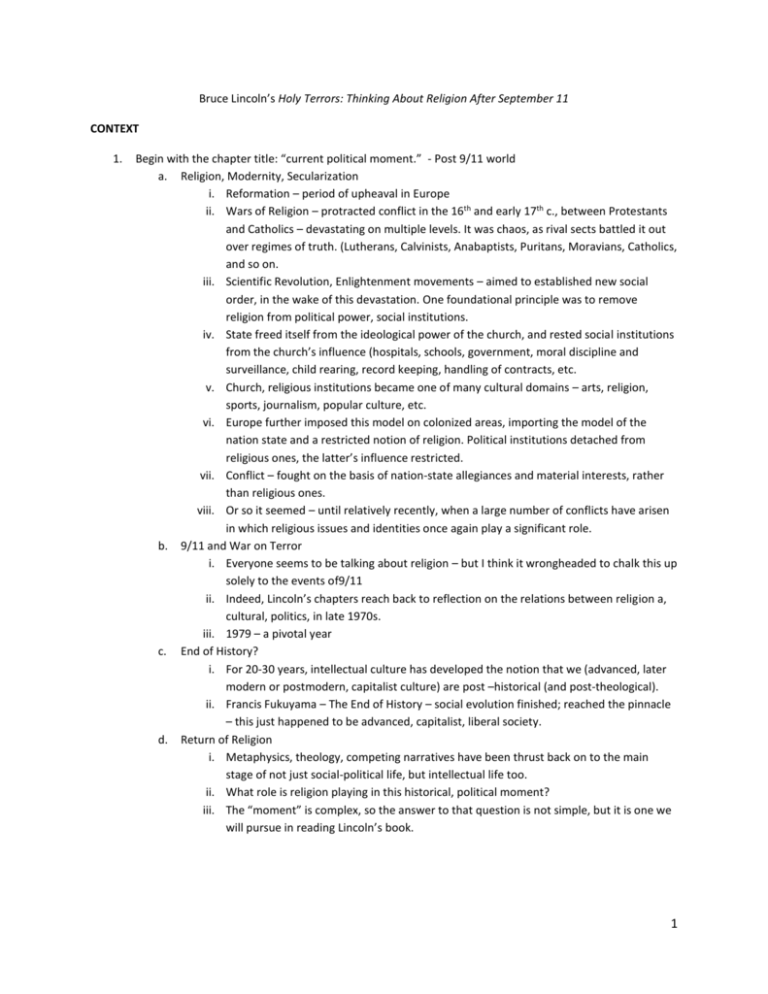
Bruce Lincoln’s Holy Terrors: Thinking About Religion After September 11 CONTEXT 1. Begin with the chapter title: “current political moment.” - Post 9/11 world a. Religion, Modernity, Secularization i. Reformation – period of upheaval in Europe ii. Wars of Religion – protracted conflict in the 16th and early 17th c., between Protestants and Catholics – devastating on multiple levels. It was chaos, as rival sects battled it out over regimes of truth. (Lutherans, Calvinists, Anabaptists, Puritans, Moravians, Catholics, and so on. iii. Scientific Revolution, Enlightenment movements – aimed to established new social order, in the wake of this devastation. One foundational principle was to remove religion from political power, social institutions. iv. State freed itself from the ideological power of the church, and rested social institutions from the church’s influence (hospitals, schools, government, moral discipline and surveillance, child rearing, record keeping, handling of contracts, etc. v. Church, religious institutions became one of many cultural domains – arts, religion, sports, journalism, popular culture, etc. vi. Europe further imposed this model on colonized areas, importing the model of the nation state and a restricted notion of religion. Political institutions detached from religious ones, the latter’s influence restricted. vii. Conflict – fought on the basis of nation-state allegiances and material interests, rather than religious ones. viii. Or so it seemed – until relatively recently, when a large number of conflicts have arisen in which religious issues and identities once again play a significant role. b. 9/11 and War on Terror i. Everyone seems to be talking about religion – but I think it wrongheaded to chalk this up solely to the events of9/11 ii. Indeed, Lincoln’s chapters reach back to reflection on the relations between religion a, cultural, politics, in late 1970s. iii. 1979 – a pivotal year c. End of History? i. For 20-30 years, intellectual culture has developed the notion that we (advanced, later modern or postmodern, capitalist culture) are post –historical (and post-theological). ii. Francis Fukuyama – The End of History – social evolution finished; reached the pinnacle – this just happened to be advanced, capitalist, liberal society. d. Return of Religion i. Metaphysics, theology, competing narratives have been thrust back on to the main stage of not just social-political life, but intellectual life too. ii. What role is religion playing in this historical, political moment? iii. The “moment” is complex, so the answer to that question is not simple, but it is one we will pursue in reading Lincoln’s book. 1 CHAPTER 1 – The Study of Religion in the Current Political Moment 1. 2. 3. Lincoln begins his study by asking, What do we take religion to be? a. Geertz and Talal Asad’s critique – 2 levels to it i. Asad’s critique: Geertz is premised on an Enlightenment assumption about the nature of religion - “clearly delimited religion”; Lincoln spends some time on this, as it is central to his approach (p. 3). b. Domain model of culture i. Case of Sayyid Qutb (d. 1966) – p. 4 – don’t characterize as representative of “Islam” – rather, need something more analytical ii. Lincoln: - different cultural set-ups rooted in differences with respect to how religion imbricates, penetrates, controls iii. Maximalist and Minimalist – p. 5 A Definition/Approach to Religion a. minimum constituent elements of religion (essentialist, analytical, functional) b. Discourse – claims (human claims, shrouded, enveloped in a discourse about the transcendent, the more-than-human) c. Community – religion creates, sustains communities – not individual in solitude, but communal affiliations - culture d. Practice – not only belief, but behavior, ethics, gestures, dress, foods, use of space, ceremony, ritual e. Institution – organize, promote, regulate, govern, defend i. Christianity – episcopal, Presbyterian, congregational ii. Laws, rules, regs Case, Hijackers Instructions a. p. 8 - Instructions to hijackers – unpacks with reference to these four b. p. 14 – the mythic/narrative pattern c. p. 16 – an important page here – not Islam; rather: Islamism, radical Islam d. p. 16 – bin Laden’s motives are “intensely and profoundly religious” – [and political?] Questions 1. 2. 3. 4. Lincoln mentions Asad’s critique of Geertz’s definition. Summarize his critique (both the narrow and the broad critique). Who was Sayyid Qutb? How did he critique American culture? Lincoln uses his 4 constitutive elements (discourse, practice, community, institution) to unpack the September 11 hijacker’s instructions. What do you make of his interpretation? Do you see any problems with it? Can you apply these elements to a case or example with which you are familiar? 2 CHAPTER 2 – Symmetric Dualisms 1. 2. 3. 4. 5. 6. 7. Analysis of the speeches of bin Laden and G.W. Bush “terrorists,” “freedom fighters”, “infidels” p. 22 – heroes, villains, fence-sitters, children p. 24 – civil religion (religion directed toward the state) authority – religious/charismatic vs. state (recall Weber) p. 26 – Palestine – if Palestinians were treated with justice, twin towers might still be standing – Discuss? “removal of troops prime goal” – cf. with p. 16. – a political, not a religious goal, no? Perhaps religion plays instrumental role, but the goal is political. Point: can’t really distinguish between the two domains? If we can’t, doesn’t Lincoln’s entire argument actually collapse? 8. http://en.wikipedia.org/wiki/File:US_military_bases_in_the_world_2007.svg (map of troop deployments) 9. Me: 9/11 gave support to an overt imperial agenda that had been brewing in Washington before the attacks. This “process of [foreign policy] transformation, even if it brings revolutionary change, is likely to be a long one, absent some catastrophic and catalyzing event – like a new Pearl Harbor” (“Rebuilding America’s Defenses: Strategies, Resources, and Forces for a New Century,” A Report of The Project for the New American Century, September 2000, p. 51), http://www.newamericancentury.org/RebuildingAmericasDefenses.pdf, (accessed April 10, 2006). Al Qaeda granted the group’s wishes on 9/11. 10. p. 29 – the hypocrites - “They backed the butcher against the victim, the oppressor against the innocent child.” – Who are these “hypocrites”? What are we to make of this notion? Is America a “butcher”? Knowing our history. 11. p. 30 – God continue to bless America – “the tip of a vast subtextual iceberg.” – Need to explore this iceberg a bit; come back to it shortly. Questions What are the similarities and differences he finds in the speeches? Summarize Lincoln’s major claims in this chapter in your own words 3 CHAPTER 3 – Jihads, Jeremiads and the Enemy Within An analysis of the Falwell-Robertson discussion post 9/11, on September 13 – a clip on the course website from YouTube 1. 2. 3. 4. 5. 6. p. 33 – the two senses of jihad - a “prime categorical distinction” both moral and spatial - the two realms; p. 33-34 – the two sense of “Islam” – specific religion; idealized state of peace How does this distinction compare, for example, with Evangelical Christianity? p. 34 – sharp binary distinctions not unique, by any means, to Islam, (or to currents within Islam) p. 35 – important passage here: “arrived at this tendentious conclusion by strictly religious means…. He interprets [the present] in terms of paradigms known from texts considered a “sacred reservoir of timeless truths” – THE SUBTEXTUAL ICEBERG cf: Bush on bin Laden Q: Do you want bin Laden dead? Mr. Bush: I want justice. There's an old poster out west, as I recall, that said, "Wanted: Dead or Alive"…. Q: Are you saying you want him dead or alive, sir? Can I interpret -Mr. Bush: I just remember, all I'm doing is remembering when I was a kid I remember that they used to put out there in the old west, a wanted poster. It said: "Wanted, Dead or Alive." All I want and America wants him brought to justice. That's what we want. - George W. Bush, “Guard and Reserves ‘Define Spirit of America,’” http://www.whitehouse.gov/news/releases/2001/09/20010917-3.html 7. Lincoln, p. 35 –“What we have is a situation of mutual mediation, in which the actor’s temporal situation of interest provides the lens through which he consults the canonic, putatively timeless text…. Familiarity with the text… provides the lens through which he understands and responds to his situation.” “Of course our whole national history has been one of expansion…. That the barbarians recede or are conquered, with the attendant fact that peace follows their retrogression or conquest, is due soleyl to the mighty power of the mighty civilized races which have not lost the fighting instinct, and by which their expansion are gradually brining peace into the red wastes where the barbarian peoples of the world hold sway. –Theodore Roosevelt, The Strenuous Life, 1901 8. Lincoln, p. 36 – analysis of theologically, biblically informed mythic paradigms that shaped the response of prominent evangelical Christians to 9/11 9. p. 37 – very important: liberalism, secularism, civil rights, etc. – “created an environment which possibly has caused God to lift the veil of protection…” - see also p. 39, bottom 10. Part of manifest destiny myth - Puritan America, 17th c. "Thus stands the cause between God and us. We are entered into covenant with Him for this work. We have taken out a commission. ... For we must consider that we shall be as a city upon a hill. The eyes of all people are upon us…. "We are commanded this day to love the Lord our God, and to love one another, to walk in his ways and to keep his Commandments and his ordinance and his laws, and the articles of our Covenant with Him, that we may live and be multiplied, and that the Lord our God may bless us in the land whither we go to possess it. But if our hearts shall turn away, so that we will not obey, but shall be seduced, and worship other gods, our pleasure and profits, and serve them; it is propounded unto us this day, we shall surely perish out of the good land whither we pass over this vast sea to possess it." - John Winthrop, ‘Model of Christian Charity, 1630’ 4 11. And where did Winthrop get this from? And where did Winthrop get this from? – biblical; Lincoln focuses on some passages from II Chronicles, but this theme of punishment for falling away from God is central to the so-called “Old” Testament 12. What is his point here? For Falwell and Robertson, “The attackers of September 11 were not really the enemy in an absolute sense. As God’s scourge, the were instruments of divine purpose…” p. 43-44). See also notes 13 and 17, pp. 118-119. 13. P. 49 – aim: to reconstruct the nation as a Christian entity. – see conclusion, p. 49-50 Questions, Chapter 3: 1. Who are Jerry Falwell and Pat Robertson? 2. What do you make of Lincoln’s anlaysis of what the two men had to say following 9/11? 3. If, as Lincoln argues, religious discourse seeks to elevate claims to transcendent, immutable truths, and hence protect these claims form criticism, what is the alternative(s)? Relativism, for example? Science? Reason? Apathy? Must truth, objectivity, universality be tossed out the window? Postmodernism certainly has, partly due to the kind of critique levelled by Lincoln. 5 CHAPTER 4 - On the relation of religion and culture Culture – group + identity - - P. 51 - language + other “non-verbal systems of signification” Culture is a signifying practice; Culture is what we learn; shapes identity, sense of belonging; Culture is what we are willing to die for… to kill for? P. 52 – “the other” – strangers – “those whose behaviors and judgments fall outside the range the group construes as normal”; “the prime instrument through which groups mobilize themselves, construct their collective identity, and effect their solidarity by excluding those whom they identify as outsiders…” “tool” – create, fashion, manufacture – if there is a tool, there is someone who makes it and uses it Sec. II – the big C-Culture vs. little c-culture, distinction Sec. III - Hegemony; Culture beds power down The ‘x’, the content of culture: o aesthetics – taste, pleasing, style, form o ethics – evaluative – how pleasing? How good? How tasteful? Sec. IV – religion in addition to ethics, aesthetics, there is religion p. 55 (an important page) - religion (a definition) – “that which invests specific human preferences with transcendent status by constituting them as revealed truths, ancestral traditions, divine commandments, and the like.” – shroud o What kind of definition is this? o To what kinds of phenomena does it focus attention? o What aspects of religion is Lincoln’s approach ill-equipped to handle? o Similar in a way to Geertz, who he earlier criticized (worldview + ethos) Again, the epistemology question– how do we know what we know? P. 55 – shift from aesthetic and ethical discourse to religious is “transformation of enormous importance” – human propositions are misrepresented as more than human, and thereby insulated against critique o Applies a Hermeneutic of suspicion to any transcendent discourse “A believing Muslim woman who covers her hair with a scarf, for instance, need not view this as a surrender to her parent’s wishes to keep her asexual, nor to patriarchal domination in general. Rather, she is encouraged to regard this as an act of self-fashioning, executed in conformity to precepts established by God, revealed through his prophet, and maintain by his people” (p. 56). he hits the nail on the head here - what do we make of Lincoln’s claim? – THIS IS CENTRAL QUESTION insider – outsider – the expert who really knows what it is about vs insider who is deluded “for better and also for worse…” p. 56 Sec. V – VIII - Enlightenment; maximalist and minimalist religion; colonization - “when rival aesthetic and religious preferences are couched in religious terms, far from being suppressed, the conflict can be gravely exacerbated…” p. 57 6 CHAPTER 5 – Religious Conflict and the Postcolonial state p. 63 - Question: What is the distinction between “nation” and “state”? p. 63 – religion can be foundational to national identity; the nation can acquire a religious aura (civil religion) – Durkheim – nationalism as the religion of the secular state Remainder of the chapter - four different types of conflict; the various ways in which religious identities, the state and the nation interact. Example: the film Syriana p. 74 – Lincoln’s summary remarks Chapter 6 – Religion, Rebellion, Revolution Question: Lincoln divides approaches/definitions of religion into 2 types: “romantic” & “materialist” – DESCRIBE THESE TYPES – WHICH BEST FITS LINCOLN’S APPROACH? p. 78 - Lincoln also states that, in spite of differences, these two approaches are in many ways in close agreement. EXPLAIN – how so? - p. 78 religions of the oppressed; need for dialectic perspective; glue – mirror – crowbar p. 79 – QUESTION: What is the chief division in the social field of tensions? What scholarship is Lincoln following here? Is this how you understand society? If I asked, What is society?, would you reply, “A field of social tensions in which factions compete for limited resources…” If not, how would you describe society? “Religion of the status quo” – “religions of resistance” – “religions of revolution” p. 81 – 82 – critique of mission work; a “few broad and provisional generalizations” – WHAT DOES LINCOLN SAY HERE IN THIS SECTION? SUMMARIZE HIS CLAIMS. p. 83 – religions of resistance p. 85 - religions of revolution – what is the difference between religions of resistance and religions of revolution? 7 Conclusions? - What are we to make of Lincoln’s way of thinking about religion? What does it have going for it? What are some problems or limitations with it? ASK YOURSELF Explain and contextualize Lincoln’s distinction between maximalist and minimalist religion. Be sure to consider his discussion religion in a post-Enlightenment context , and how these two terms relate to Lincoln’s understanding of culture. Feel free to include examples. Argue one of the following two statements (be sure to refer to concrete details of Lincoln’s argument): Holy Terrors is must-read book, as it illuminates how religion shapes conflict in today’s world. Bruce Lincoln’s fundamental thesis about the relation between religion and conflict in Holy Terrors is flawed. From Bruce Lincoln’s Theses on Method 1. The conjunction "of" that joins the two nouns in … "History of Religions" is not neutral filler. Rather, it announces a proprietary claim and a relation of encompassment: History is the method and Religion the object of study. [What constitutes this method?] [What other methods are there?] 2. The relation between the two nouns is also tense, as becomes clear if one takes the trouble to specify their meaning. Religion, I submit, is that discourse whose defining characteristic is its desire to speak of things eternal and transcendent with an authority equally transcendent and eternal. History, in the sharpest possible contrast, is that discourse which speaks of things temporal and terrestrial in a human and fallible voice, while staking its claim to authority on rigorous critical practice. [Does the latter inevitably require some form of the former?] 3. History of religions is thus a discourse that resists and reverses the orientation of that discourse with which it concerns itself. To practice history of religions in a fashion consistent with the discipline's claim of title is to insist on discussing the temporal, contextual, situated, interested, human, and material dimensions of those discourses, practices, and institutions that characteristically represent themselves as eternal, transcendent, spiritual, and divine. [Why this insistence?] 8
